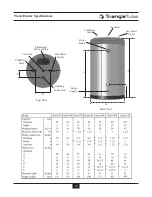
Water Heater Maintenance
25
Maintenance Schedule
Annual service by qualified service technician
should include the following:
Any procedure required by local codes.
Check air vent operation.
Verify system pressure. Air venting proce-
dure may require adding water to bring sys-
tem up to pressure, typically 12 psig.
Manually operate T&P relief valve at least
once a year. This will release some hot water.
Before operating T&P relief valve, make
sure no one is in front of or around T&P
relief valve discharge piping. Hot discharge
water can cause severe personal injury or
substantial property damage.
Move operating lever to open position for a
few seconds and then move it back, allowing it
to snap closed. After T&P relief valve is oper-
ated, if it continues to release water, close cold
water inlet to water heater immediately.
Follow draining instructions, to relieve pres-
sure from the inner tank and replace T&P relief
valve. If T&P relief valve weeps periodically,
it may be due to thermal expansion see
Thermal Expansion, page 5. Do not plug T&P
relief valve or discharge piping.
Plugging T&P relief valve or discharge pip-
ing can cause excessive pressure in water
heater, resulting in severe personal injury,
death, or substantial property damage.
Follow instructions on circulator to oil it, if
required.
Check mixing valve, valves, pipes and fit-
tings for leaks.
Check function of field-installed controls
and valves. See component manufacturer’s
instructions.
Review homeowner’s maintenance responsi-
bilities and their frequencies, including any
not listed in the following section.
Homeowner monthly maintenance to include:
Check air vent operation.
•
Automatic air vent - remove hygroscopic
cap. Briefly push in valve and release it to
clean valve seat. Screw cap on completely.
If air vent does not operate, call qualified
service technician.
Visually check valves, pipes and fittings for
leaks. Call qualified service technician to
repair leaks.
Filling Water Heater
See “Filling the Inner (Domestic Water) Tank and
“Filling the Outer (Boiler Water) Tank” on page 22.
Draining Water Heater
Drain water heater if it will be shut off and exposed
to freezing temperatures. Freezing water will
expand and damage water heater.
•
If boiler water contains sufficient
antifreeze, then only the domestic water
needs to be drained.
Close boiler water isolation valves and
relieve system pressure to below 15 psig in
outer tank before draining inner tank to
prevent damage to inner tank.
•
If boiler water does not contain sufficient
antifreeze, then the boiler water and
domestic water must be drained.
If antifreeze is used in boiler water, check concen-
tration. Boiler water (including additives) must be
practically non-toxic, having toxicity rating or
class of 1, as listed in Clinical Toxicology of
Commercial Products. A maximum 50/50 mixture
of inhibited propylene glycol is recommended.
Follow antifreeze manufacturer’s instruction.
WARNING
WARNING
DANGER








































